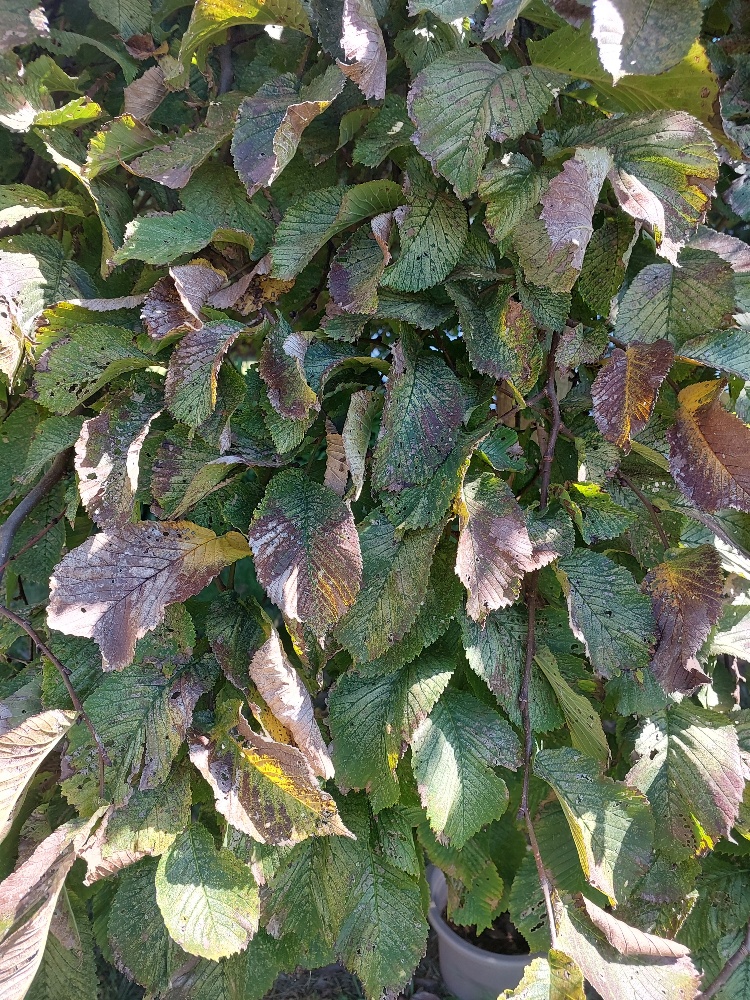
02 Apr Are Your Elm Trees Looking Sick?
PLANT DOCTOR – Elm Leaf Beetle
Has anyone noticed the leaves of their Elms trees look quite brown and mottled?
The Golden Elms will suffer from an Elm Leaf Beetle attack. All species of Elm can be affected however Chinese Elms are less likely.
Identification
The elm leaf beetles are about 5mm long with a yellow / green / brown body with two black/brown stripes. The larvae stage of the elm leaf beetle is a grub that varies in colour from black/brown and yellow, depending on its age.
Damage caused.
Both the beetles and larvae stage will eat or skeletonize the leaves of Elms. Causing the Elms to defoliate. This can then make the trees more susceptible to other diseases as they are unable to photosynthesize.
This in turn will affect the trees vigour, ability to fight disease and overall health. Quite often the damage may be more prominent on one side of the tree. Here in southern NSW, Australia this is most likely the northern side of the tree. This may indicate where the beetles first originated from.
The adult beetle will leave a “shot hole” appearance in the leaf. Whilst the beetle larvae will eat all of the green part of the leaf leaving a skeletonised leaf. Trees can be defoliated in a very short period of time. If conditions are hot, then this can happen quite fast as higher temperatures will increase the metabolism of the insect. The damage always looks the worst towards the end of summer especially if we have had hot dry weather. If you stand back and look at the tree from a distance it will have a brown tinge throughout the total canopy.
Lifecycle
Around October as temperatures start to rise the beetles will emerge out of hibernation from where they have been sheltering and move up the tree or fly to a tree. They will then lay their eggs on the leaves of the tree in mid-October (timing will be dependent on your location and the season). The eggs are yellow in colour. The larvae (grubs) will hatch in December and then the larvae (grubs) will start to move back down the tree in January. This lifecycle will repeat itself a few times through the warmer months. As the temperatures begin to drop the larvae will move to the soil or under the bark of the tree or on structures to hibernate for the cooler months (normally from May to September)
Treatments
Stem injections – This is the most effective and environmentally friendly way of treating trees for the Elm Leaf Beetle especially if they are quite established. Injections are normally completed whilst the tree is actively growing. Ideally in Young you would aim for October. Stem injection should be carried out by a licensed qualified horticulturist or arborist. Stem injection should help protect the trees for two or more years.
Canopy Spraying -This needs to be completed when the tree’s canopy is in full leaf. This should be carried out by a licensed qualified horticulturist or arborist. Also, consideration needs to be taken for surrounding vegetation, waterways and land usage.
Soil Drenching/Soil Injection – This is NOT recommended. This has a high impact on the soil and the environment around the tree. It is not recommended to be used in riparian zones and can kill microorganisms in the soil.
Trunk banding – This is a successful organic method that won’t destroy the beetle however it will disrupt the lifecycle of the insect. Apply adhesive tape, with the sticky side facing outwards, around the main trunks of the tree. This tape will catch any migrating larvae that are heading down to the ground to pupate. The tape will need to be applied by early December. It will need to be replaced every few days as the adhesiveness wears off and the number of larvae collected increases. This may not have an effect in the first year or two but overtime it should reduce the number of beetles in your area.
Introduce some predator two legged friends. Ducks and chickens seem to be a good control method over a few years. They will eat the grubs and reduce further numbers of the insect the following year.
Another factor is ensuring the trees are as healthy as possible. You can do this by keeping the trees well-watered, especially through drier conditions. Their main feeder (growing roots) are found towards the edges of the canopy. Keep trees well mulched. Improve the organic matter in the soil around the tree by fertilising the trees in September with general purpose balanced fertiliser. Ensure there is no compaction around the root zones of the trees.
Plant more flowers to encourage beneficial insects such as lacewings, hover flies and predatory insects that will feed on the eggs of the beetles.
I hope you can treat your Elms. If more people are able to treat their Elm trees in your area then the overall effects of these beetles should be reduced. It is also very important to get council’s on board for them to treat their street trees and park trees otherwise we will loose whole populations of some species.



